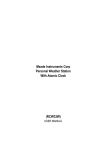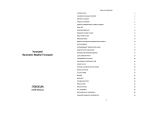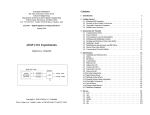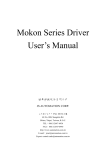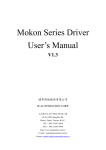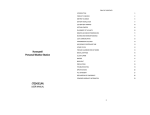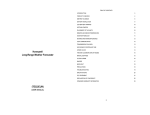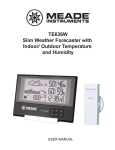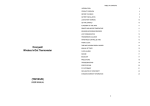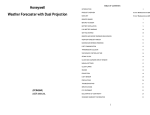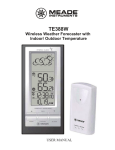Download Meade TE278W-M Instruction manual
Transcript
TE278W-M Wireless Indoor/ Outdoor Thermometer with Atomic Clock INTRODUCTION Thank you for selecting a Meade Instruments Wireless Indoor/ Outdoor Thermometer with Atomic Clock. This device combines precise time keeping, monitoring and displaying of current temperature data from up to three remote locations. Meade Instruments is the world’s leading designer and manufacturer of telescopes for professional and amateur astronomers – famous for its innovative, high performance telescopes at affordable prices. Meade Instruments now brings that same passion for innovation and high performance to its own line of precision, feature rich weather stations. Please read this instruction manual so that you can get the most enjoyment out of your Meade Instruments weather station. In this package you will find: • One (1) main unit (receiver) • One (1) remote sensor (transmitter) • One (1) User Manual Please keep this manual handy as it contains practical instructions, technical specifications and precautions. 2 PRODUCT OVERVIEW MAIN UNIT FEATURES • Time automatically sets to the US Atomic Clock • 12 or 24 hours time format • Dual crescendo time alarm with snooze • Day of the week displayed in English, Spanish, French, German and Italian • Wireless reception of the temperature from the remote sensor to the main unit from up to 160 feet (50 meters) away • Multi-channel capability to monitor temperature in up to 3 remote locations • Minimum and maximum memory for indoor and remote temperature • Programmable Ice Warning Alarm • Low battery indicator FRONT/REAR VIEW A H I C D G E B F J A. TEMPERATURE AND CLOCK window B. CHANNEL button • Recalls a different remote sensor reading – 1,2 or 3 C. UP ( ? ) button • Increases the parameters • Activates US Time Zone selection mode • Activates manual search for atomic time signal • Enables time alarms (W) and (S) and Ice Warning Alarm 3 D. MODE button • Toggles between time modes - time with seconds and time with the day of the week • Activates clock’s manual programming mode E. DOWN ( ? ) button • Decreases the parameters • Activates manual remote channels search • Disables time alarms (W) and (S) and Ice Warning Alarm F. ALARM button • Allows toggling between the calendar display and three time alarm modes • Allows programming available alarms G. MEM button • Toggles between current, minimum, maximum readings of the indoor and remote temperature • Clears the temperature memory H. WALL- MOUNT RECESSED HOLE • Keeps the unit on the wall I. BATTERY COMPARTMENT • Requires 2 (two) UM-3 or AAA 1.5V alkaline batteries J. BUILT-IN TABLE STAND • Holds unit in upright position on a flat surface REMOTE SENSOR FEATURES • Remote temperature transmission to the main unit via 433 MHz frequency • Case can be wall mounted using built-in hanger • Three channel selection 4 A. LED INDICATOR • Flashes once when the remote sensor transmits a reading to the main unit. • Flashes twice when battery power is low. B. BATTERY COMPARTMENT • Requires two AA-size batteries C. RESET • Resets all previous settings D. CHANNEL SWITCH • Selects the desired channel -1, 2 or 3 E. WALL-MOUNT RECESSED OPENING • Keeps the remote sensor on the wall BEFORE YOU BEGIN • We recommend using alkaline batteries for the remote sensor and the main unit. If outdoor temperatures regularly fall below 32°F (0°C), we recommend using lithium batteries. • Avoid using rechargeable batteries. (Rechargeable batteries cannot maintain correct power requirements). • ALWAYS install batteries in the remote sensor before the main unit. • Insert batteries before first use, matching the polarity as shown in the battery compartment. • Press RESET after each battery change with a paper clip or similar tool. • During an initial setup, place the main unit close to the remote sensor. • After reception is established (the remote temperature will appear on the main unit’s display), position the remote sensor and the main unit within the effective transmission range of 160 feet (50 meters). • The remote sensor can be placed indoors or outdoors, depending on the area where the temperature is intended to be measured. If you intend measuring outdoor elements, place remote sensor outdoors • The main unit must be placed indoors. NOTE: 1. Avoid pressing any buttons on the main unit before the remote readings are displayed. 2. The effective operating range may be influenced by the surrounding building materials and how the receiver and transmitter are positioned. 3. Place the remote sensor so that it faces the main unit (receiver), minimizing obstructions such as doors, walls, and furniture. 4. Though the remote sensors are weather-resistant, they should be placed away from direct sunlight, rain or snow. The best suggested location for the remote sensor for outdoors is under the eave on the north side of the building. NOTE: When the temperature falls below freezing point 32°F (0°C), battery voltage will drop which may result in reduced the transmission range. For optimum performance in cold conditions, we recommend using lithium batteries. 5 BATTERY INSTALLATION REMOTE SENSOR NOTE: Install the batteries and select the channel before mounting the remote sensor. • Remove the screws from the battery compartment with a small Phillips screwdriver (not included). • Set the channel 1 through 3. The switch is located in the battery compartment. Channel 1 is typically selected if only one remote sensor is being used. • Install two (2) AA size batteries (not included) matching polarity as shown in the battery compartment. • Replace the battery compartment door and secure the screws. • Secure the remote sensor in the desired location. MAIN UNIT • Remove the battery door located at the back of the main unit. • Insert two (2) AAA size batteries according to the polarities shown and replace the battery compartment door. • When placing the main unit on the table or other horizontal surface, unfold and adjust the table stand for the desired viewing angle. LOW BATTERY WARNING REMOTE SENSOR A low-battery indicator [ ] will appear next to the outdoor temperature reading of the main unit warning that the corresponding batteries need replacement. MAIN UNIT A low-battery indicator [ ] will appear next to the time display of the main unit warning that the corresponding batteries need replacement. PLACEMENT REMOTE SENSOR • The remote sensor should be placed under eaves or a similar location with free air circulation, sheltered from direct sunlight and extreme weather. • Ideally, place the remote sensor over soil, rather than asphalt, which would cause false readings. • Avoid placing the remote sensor near sources of heat, such as chimneys and heating elements. • Avoid areas that collect heat from the sun and radiate heat, such as metal, brick or concrete structures, paving, and patios. • The international standard for the valid air temperature measurements is 4 feet (1.25 meters) above the ground. MAIN UNIT • Make sure that the main unit is locating within the operating range of all remote sensors. • Ideally the main unit should be placed within line of sight of remote sensors. Avoid placing the main unit where surfaces emitting and radiating heat (e.g. heating ducts or air conditioners) and areas with interference from wireless devices (e.g. cordless phones, radio headsets, baby monitoring devices and other electronics). 6 GETTING STARTED After batteries are installed; remote sensor will transmit temperature data at 45 second intervals. The main unit may take up to two minutes to receive the initial readings. Upon successful reception, remote temperature will appear on the top line of the main unit’s display (the default remote channel is channel one). The main unit will automatically update readings at 45-second intervals. After communication between the main unit and remote sensor has been established, secure the remote sensor in the desired location. If no signal is received from the remote sensor within two minutes, dashes [- - -] will be displayed. Press and hold the DOWN (? ) button on the main unit for two seconds to initiate another signal search. REMOTE AND INDOOR TEMPERATURE The remote temperature information line is located on the top line of the main unit’s display. The wave icon is located above the remote channel number indicates the reception status from the corresponding remote sensor. There are three following types of the reception status may be displayed: The unit is in a searching mode. Temperature reading is securely registered. No signals detected. The indoor temperature with the icon IN is located below the remote temperature information line. NOTE: If the indoor or remote temperature goes above or below operating range stated in specifications, the main unit’s display ( weather) will show dashes “- - -” on the corresponding line. MAXIMUM AND MINIMUM READINGS The maximum and minimum record of the indoor and remote temperature will be automatically stored in the memory of the main unit (receiver). To display the minimum, maximum or the current reading press MEM button. If no button is pressed for the next 15 seconds, the unit will return to the current temperature and humidity display. To clear the memory, press and hold MEM button for two seconds and all previously stored readings will be erased. LOST COMMUNICATION If the main unit display line for the remote sensor reading goes blank, press and hold DOWN (? ) button for 2 seconds to begin a new signal search. If the signal still isn’t received, please make sure that: • The remote sensor is in its proper location. • The distance between main unit and remote sensor(s) is not over 160 feet (50 meters) • The path between units is clear of obstacles. Shorten the distance if necessary. • Fresh batteries are installed correctly in both remote sensor and main unit. 7 If there is no reception, please perform the following steps: • Bring the main unit and remote sensor close together. • Remove four (4) small screws from the back of the remote sensor with small Phillips screwdriver, and open the battery compartment. • Remove the batteries from the battery compartment and reinstall them in the same manner. Remote sensor LED indicator will flash showing transmission of the signal. • Remove the batteries from the main unit and reinstall them in the same manner. • On the main unit select the same channel number using CHANNEL button as set on the remote sensor. The remote temperature appeared on the main unit’s display will show that transmission is being received successfully. TRANSMISSION COLLISION Signals from the other household devices such as wireless doorbells, home security systems, and entry control, may interfere with this product or cause temporary reception interruption. This is normal and will not affect the general performance of the product. The transmission and reception of the temperature and humidity readings will resume once the interference subsides. WWVB RADIO CONTROLLED TIME The NIST (National Institute of Standards and Technology) radio station (WWVB) is located in Ft. Collins, Colorado. It transmits an exact time signal continuously throughout the most of the continental United States at 60 KHz frequency. The unit can receive this WWVB signal through the internal antenna from up to 2,000 miles away. Due to the nature of the Earth’s ionosphere, reception can be limited during the daylight hours. The radio controlled clock will search for an alternate station that receives the atomic time signal from the NIST Atomic clock in Boulder, Colorado. The WWVB tower icon on the unit’s display will flash indicating a radio signal reception from the WWVB station. If the tower icon is not fully lit, or if the time and date are not set automatically, please consider the following: • During night-time hours, atmospheric disturbances are typically less severe and radio signal reception may improve. A single daily reception is sufficient enough to keep the clock accuracy within 1 second. • Make sure the unit is positioned at 8 feet (2 meters) distance from any interference source such as a TV, computer monitor, microwave, etc. • Within concrete wall rooms such as basements or office buildings, the received signal may be weakened. Always place the unit near the window for better reception. ATOMIC CLOCK Immediately after establishing communication between the main unit and remote sensor, the atomic time signal receiver will open and start to search for the atomic time signal. The search usually takes between 5-8 minutes. NOTE: Do not press any buttons on the main unit during auto search as it may interrupt product’s operation, and you will need to start set up procedure again. Once the atomic time signal is received, the date and time will be set automatically, and the [ ] icon will appear. NOTE: It is necessary to set your Time Zone, having in mind that the default zone is a US Pacific Standard Time (PST). (Refer to MANUAL SETTINGS section) If the time signal has not been received in 8 minutes, you may use the MODE button to set the time and date manually. (Refer to the MANUAL SETTINGS section). After the clock is set manually, place the Weather Station by the window for the better reception. The atomic clock receiver is programmed that it will continue to search for the atomic time signal daily for every hour between 1:00 am and 4:30 am. Once the time signal has been successfully received, the time and date will be updated automatically. 8 TIME AND CALENDAR DISPLAY MODES The unit displays current time in two display modes, in “hour-minutes-seconds” format and in “hour-minutes-day” format. The calendar is displayed in month-date format. MANUAL SETTINGS It is necessary to set the desired US TIME ZONE. TIME ZONE • Press MODE button once so that the Day of the Week abbreviation is displayed to the right of the time; for example: pm 2:37tu • Select the Time Zone by pressing and holding UP ( ? ) button for 3 seconds • Keep holding UP ( ? ) button until the desired US Time Zone (Pacific, Mountain, Central or Eastern) is highlighted on the display’s US map, located to the right of the time display and above the day of the week • Release the UP (? ) button. The Time Zone is set CLOCK • Press and hold MODE button for 3 seconds: the year will flash. Press UP (? ) or DOWN (? ) to change flashing digits. • After the year is set, press MODE button to confirm and move to the next parameter (month) • Continue setting month, date, hour, minutes, language for the day of the week and temperature in Fahrenheit or Celsius • Press MODE for the last time to return to the time of day with seconds, after the last parameter is set CLOCK ALARMS The unit has two time alarms – Weekday alarm (W) and Single day alarm(S) - and one Ice Warning Alarm (PRE-AL). • If Weekday (W) alarm is activated, it will sound at the set time and the alarm icon will flash Mondays through Fridays • If Single (S) day alarm is activated, it will sound at the set time and the alarm icon will flash only for this specific day and will not activate on subsequent days • If Ice Warning Alarm ( PRE-AL) is activated, in will sound at the set time and alarm icon will flash once the remote temperature for Channel One (1) will reach 32°F(0°C) and below NOTE: Ice Warning Alarm can be set only if one or both - Weekday or Single alarm - are programmed. SETTING THE WEEKDAY (W) AND SINGLE DAY (S) ALARMS • Press ALARM button once to enter into the alarms setting mode. The default alarm is a Weekday alarm (W). The abbreviation “OFF” with a letter “W” next to it will be displayed, if the alarm has not been set previously • Press and hold ALARM button for two seconds. The hour digit will flash • Adjust the hour using UP ( ? ) or DOWN ( ? ) buttons • Press ALARM button again. The minute digits will flash • Adjust the minutes using UP (? ) or DOWN (? ) buttons • Press ALARM button again to confirm and the weekday alarm time will be set • Set Single (S) day alarm if desired in the same manner 9 SETTING THE ICE WARNING ALARM (PRE-AL) If Weekday (W) or Single day (S) alarm is set, the Ice Warning Alarm (Pre-AL) can be programmed. • Press ALARM button once to enter into the Ice Warning Alarm setting mode. The abbreviation OFF with a PRE-AL next to it will be displayed. • Press and hold ALARM button for two seconds. The number 30 will flash, meaning that if selected, the alarm will sound 30 minutes earlier than the Weekday or Single alarm. • Select the desired Ice Warning Alarm interval in 15 minutes increments between 15 and 90 minutes, using UP (? ) or DOWN (? )buttons • Press ALARM button to confirm and exit from the alarm setting mode. ACTIVATING THE ALARM • Press ALARM button to enter into the desired alarm mode. • Press UP (? ) to activate or DOWN (? ) to deactivate desired alarm. When alarms are activated, the corresponding icons W, S or PRE-AL will be displayed. PRECAUTIONS This product is engineered to give you years of satisfactory service if handled carefully. Here are a few precautions: • Do not immerse the units in water. • Do not clean the units with abrasive or corrosive materials. They may scratch the plastic parts and corrode the electronic circuits. • Do not subject the product to excessive force, shock, dust, temperature, or humidity, which may result in malfunctions, shorter lifespan, damaged batteries, and damaged parts. • Do not tamper with the units internal components. Doing so will invalidate the warranty and may cause damage. These units contain no user-serviceable parts. • Use only fresh batteries. Do not mix new and old batteries. • Read the user's manual thoroughly before operating the units. TROUBLESHOOTING Check here before contacting customer service. Issue Symptom Main unit US Atomic Time signal is not received Place unit by the window and keep it there overnight Cannot locate remote sensor Check batteries Remote sensor Solution Check location Press and hold DOWN ( ? ) button on the main unit to search for the signal form the remote sensor Cannot change the channel Press “RESET” after setting the channel Data does not match data on the main unit Initiate manual sensor search (Press and hold DOWN ( ? ) button on the main unit) 10 SPECIFICATIONS Main Unit Indoor Temperature Operating range: 23.0°F to 122.0°F (-5°C to +50°C) Temperature resolution: 0.2°F (0.1°C) User-selectable (°F or °C) temperature display Maximum number of remote sensors: 3 (one included) Readings update interval: every 45 seconds Low battery indicators – for each remote channel and main unit Clock Precise atomic time 4 US Time Zones 12/24 hour time format Remote Sensor Remote Temperature Operating range with lithium batteries: -40°F to 122°F (-40°C to 50°C) Temperature resolution: 0.1°C/0.2°F RF Transmission Frequency: 433 MHz RF range: Maximum 160 feet (50 meters) Temperature transmission cycle: approximately 45 seconds Low battery indicator Wall-mount of Table stand Power Main unit: 2 AAA size (UM-3) 1.5V batteries (not included) Remote Sensor: 2 AA size 1.5V batteries (not included) Dimensions Main unit: 2.76(L) x 5.51 (H) x 0.87(D) inches Remote sensor: 2.37(L) x 4(H) x 1(D) inches / 60(L) x 101(H) x 25(D) mm 11 FCC STATEMENT This device complies with Part 15 of the FCC Rules. Operation is subject to the following two conditions: (1) This device may not cause harmful interference, and (2) This device must accept any interference received, including interference that may cause undesired operation. Warning: Changes or modification to this unit not expressly approved by the party responsible for compliance could void the user’s authority to operate the equipment. NOTE: This equipment had been tested and found to comply with the limits for a Class B Digital device, pursuant to Part 15 of the FCC Rules. These limits are designed to provide reasonable protection against harmful interference in a residential installation. This equipment, installed and used in accordance with the instructions, may cause harmful interference to radio communications. There is no guarantee that interference will not occur in a particular installation. If this equipment does cause harmful interference to radio or television reception, which can be determined by turning the equipment off and on, the user is encouraged to improve or correct turning the interference by one or more of the following measures: • Reorient or relocate the receiving antenna • Increase the separation between the equipment and receiver. • Connect the equipment to an outlet on a circuit different from that to which the receiver is connected. • Consult the dealer or an experienced radio / TV technician for help. DECLARATION OF CONFORMITY We Name: Meade Instruments Corp. Address: 27 Hubble, Irvine, CA 92618 - 4209 declare that the product Product No.: TE278NLW Product Name: Wireless Weather Forecaster with Indoor/ Outdoor Temperature Manufacturer: Hideki Electronics Limited Address: Unit 2304-06, 23/F Riley House, 88 Lei Muk Road, Kwai Chung, New Territories, Hong Kong is in conformity with Part 15 of the FCC Rules. Operation is subject to the following two conditions: This device may not cause harmful interference. This device must accept any interference received, including interference that may cause undesired operation. 12 Battery Safety Instructions • Always purchase the correct size (2 x 1.5V AA, 15A/15AC/15LF ANSI, LR6/FR6 IEC), (2 x 1.5V AAA, 24A/24AC/24LF ANSI, FR03/LR03 IEC) and grade of battery most suitable for the intended use. • Replace all batteries of a set at the same time. • Clean the battery contacts and also those of the device prior to battery installation. • Ensure the batteries are installed correctly with regard to polarity (+ and -). • Remove the batteries from any unit which is not to be used for an extended period of time. • Remove used batteries promptly. • Do not mix old batteries with new batteries. • Do not mix alkaline, standard (Carbon Zinc), lithium or rechargeable (Nickel Cadmium) batteries. Caution: • If batteries or parts are swallowed, see a doctor immediately. STANDARD WARRANTY INFORMATION This product is warranted by Meade Instruments Corp. (MIC) to be free of defects in materials and workmanship for a period of ONE YEAR from date of original retail purchase in the U.S.A. MIC will repair or replace the product, or part thereof, found upon inspection by MIC to be defective, provided the defective part or product is returned to MIC, freight prepaid, with proof of purchase. This warranty applies to the original purchaser only and is non-transferable. Meade products purchased outside North America are not included in this warranty. RGA Number Required: Prior to the return of any product or part, a Return Goods Authorization (RGA) number must be obtained by writing to Meade's Customer Service Department or by calling 800-626-3233. Each returned part or product must include a written statement detailing the nature of the claimed defect, as well as the owner's name, address, phone number, and a copy of the original sales invoice. This warranty is not valid in cases where the product has been abused or mishandled, where unauthorized repairs have been attempted or performed, or where depreciation of the product is due to normal wear-and-tear. MIC specifically disclaims special, indirect, or consequential damages or lost profits, which may result from a breach of this warranty. Any implied warranties which cannot be disclaimed are hereby limited to a term of one year from the date of purchase by the original retail purchaser. This warranty gives you specific rights. You may have other rights which vary from state to state. MIC reserves the right to change product specifications or to discontinue products without prior notice. This warranty supersedes all previous Meade product warranties. Copyright (2010) Meade Instruments Corporation. All Rights Reserved. All user manual contents and information are subject to change. 13 Meade Instruments Corp. 27 Hubble Irvine, CA 92618 U.S.A. © 2011 Meade Instruments Corp. All Rights Reserved. All user manual contents and information are subject to change.














